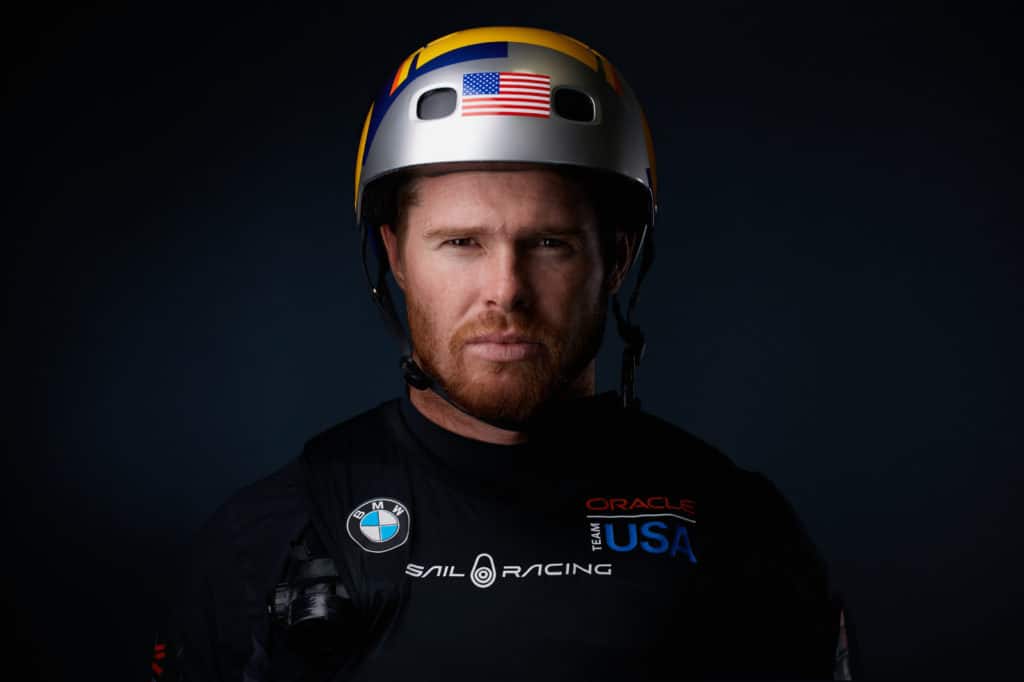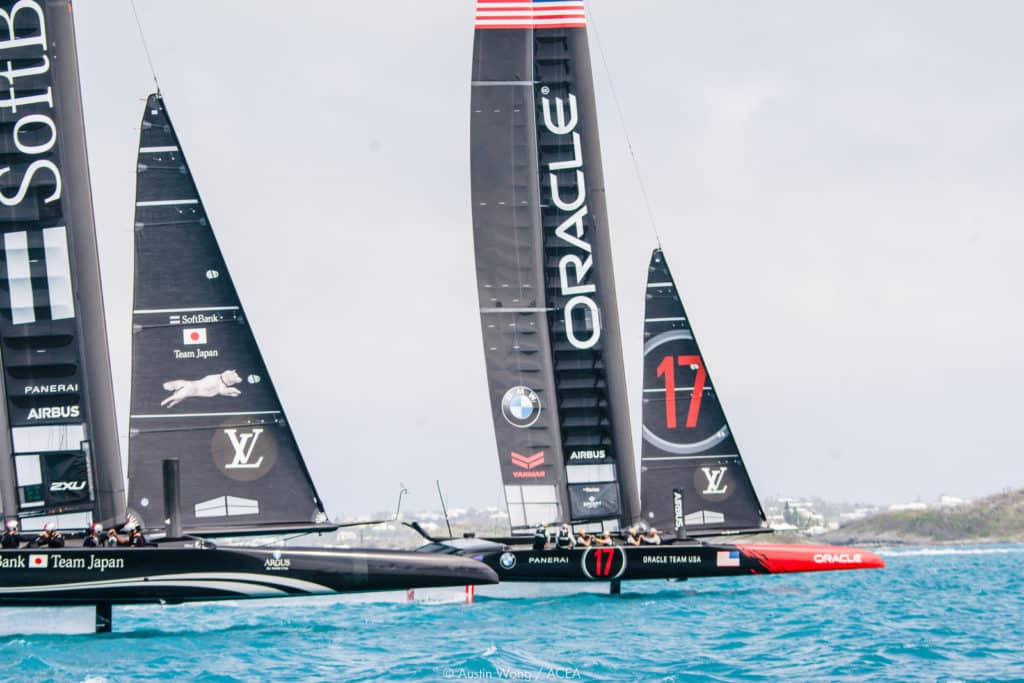
“I do a lot of homework an hour before we hit the water, and then the last 35 minutes are pretty relaxed,” says Tom Slingsby, Oracle Team USA’s helmsman, tactician and sailing team manager for the 35th America’s Cup defense, about his pre-sailing routine. Slingsby describes poring over weather charts and the latest meteorological information during these homework sessions, conducted before a full-crew meeting to discuss the day’s big-picture agenda. An inner quorum consisting of skipper Jimmy Spithill, coach Philippe Presti and Slingsby then assembles. “We come up with different tactical situations that we might encounter and what we should expect,” says Slingsby. “It’s a bit of a technical playbook.”
Mental decaffeination comes next. “I don’t put on headphones or sit in a corner and mentally prepare or anything like that,” says Slingsby, who holds Australian and U.S. passports, an Olympic gold medal, an America’s Cup win and eight world-championship titles. “I like joking with friends, playing table tennis or other games, and not really thinking of the race. I try to stay as loose as possible, and as long as I’ve done my homework, I can get ready to get on the water and into that environment.”
Come dock-out time, however, the highly professional 32-year-old knows that he’s playing with sharp edges. After all, Slingsby was aboard Oracle Team USA’s 72-foot foiling catamaran on that fateful day in October 2012 when the team destroyed their first-generation boat just west of San Francisco’s Golden Gate Bridge while practicing for the 34th America’s Cup, and his current job involves calling the tactical shots aboard — and sometimes driving — one of the most outrageous wind-driven machines ever crafted.
Even though tagging speeds in the low-50s and experiencing frightening G-forces while match racing defines intensity, OTUSA’s skipper and afterguard rely on the team’s comprehensive playbooks, years of high-level sailing experience and — in Slingsby’s case — all senses to enable them to play grandmaster-level chess while enduring fire-hose-like saline treatments and maintaining a heart rate worthy of Tour de France contenders. Here he provides us with a look at a hypothetical race around the Bermuda racetrack from the back of USA 17.
The rules governing the new America’s Cup Class boats permit the use of a hydraulic accumulator — an America’s Cup first — that allows teams to tap stored energy, rather than requiring peak moments of grinding output. This gives Spithill and Kyle Langford, the team’s wing trimmer, ample foil- and wing-trimming muscle power, but it creates a pressure-hungry beast that’s satiated only when four out of USA 17’s six-strong crew are hammering on their grinding pedestals. This high-rpm power-endurance workout begins the moment USA 17 docks out, with Slingsby pulling double duty on the handles while funneling critical data to Spithill.
“I provide information to Jimmy for the start,” says Slingsby, citing top-level data such as burn time, distance to boundaries and distance to laylines as the most mission-critical bits of pass-through information. “That’s his area [of expertise]…. He’s going to make the judgment calls [on] how we [approach] the other boat — for example, do we back off or do we attack?”
When Spithill’s characteristically elbows-out call comes to attack, the wheel spins and the towering wingsail loads up, exposing the sailors sprinting across the nets to some of the sailing world’s highest G-forces. Spithill crosses first, letting Slingsby drive USA 17 out of the turn, and then immediately assumes the new weather helm and foil controls.
“The amount of decisions that the guys have to take … the different playbook combinations [we use], and the fact that they have to do it all at exhaustion — that’s usually when you’ll make a mistake, when you’re either stressed or at exhaustion, and that’s exactly what happens sailing these boats,” says Spithill. “It’s down to split seconds — you can’t just talk about it.”
The starting signal flips a metaphoric light switch aboard USA 17. “We roll into the next phase of the race,” says Slingsby, explaining that leader-board position often comes down to a contest of inches (or boatlengths), and that successful modern America’s Cup sailing is a matter of transitioning between two objectives. “Are you attacking or are you defending? We have a different playbook for each of those scenarios. [We’re] constantly going from one playbook to another.
After USA 17 clears the first turning mark and bears away toward the leeward gate, the chess game settles into a new rhythm. “I try to cut off my opponent’s opportunity to get some [separation from] us, to really restrict their maneuvers,” says Slingsby about times when USA 17 commands the lead. “If [we’re] behind, [I’m] asking, ‘Where are my opportunities to overtake?’”
As Slingsby computes different racecourse permutations while simultaneously spinning the grinding handles, Spithill and Langford focus on flight. “Once the race starts, it’s about boatspeed,” says Slingsby. “Making sure the boat is always going at 100 percent of its capacity. [Spithill and I] talk with [Langford] about hitting our target speeds and what we can do to go faster, and if are we in the right [sailing] mode. [Jimmy’s] job is about making sure the boat is performing up to its capacity. [I’m] picking our course.”
As USA 17 screams toward the leeward gate, Slingsby calls the favored rounding side, cycling his eyes between the water and the instruments as the boat begins the uphill leg, while maintaining a heart rate in the ballpark of 170 beats per minute. “The most important [data involves] knowing where you are on the racecourse, distance to the boundaries, and time to the boundaries so we know [when to tack] so we don’t go off the course,” says Slingsby. “I’m also looking at wind direction, and I’m monitoring boatspeed, true-wind angles, and making sure the boat is sailing to its expectations.” Blinking black boxes and data-rich screens are important, says Slingsby, but these pieces of information are available to all teams. “There’s a lot of intuition involved, [for example] with [a] weather pattern changing or you might know the wind is about to change.”

America’s Cup Class (ACC) boats practice racing in Bermuda
He subjects his mental playbooks to nonstop reassessment. “If I see something in the water, if I see more wind on one side or if I feel there’s going to be a wind shift, I’m going to go off the playbook.”
Complicating matters for Slingsby, of course, is his other full-time job. “The game has changed quite a bit now with the tactician being a grinder,” he says. “When I’m on the boat, I do as much as much as I can helping out the grinders without affecting my ability to make decisions tactically.” After a final tack brings USA 17 around the starboard side of the weather gate, everyone’s attention is focused on the bear-away.
“When you go into a high-speed bear-away, it’s like a slingshot,” says Slingsby. “You’re hitting 42, 43 knots on the reaching leg, and then you might get up to 46 knots, and [with] the amount of cavitation at that point — the whole boat is shaking and shuddering — for sure, you’re on edge, because if a foil breaks at that speed, it’s pretty catastrophic.”
However sketchy the situation might become, Slingsby’s job is to always think tactically, both from the playbooks and without a net — even at 45 knots. “You’re thinking a few moves ahead,” he says. “You can outrun gusts, so it’s a matter of linking it all together. Can you make a few jibes to stay in it, or link to the next [gust] and continue on? There’s a real art to it: Link a few gusts or shifts together, and you’re going to keep it going.”
Back at the leeward gate, the team hits the repeat button, rifling off another lap around the course — full-tilt boogie — keen to stay aloft on their foils and tactically engaged as they work to refine their playbooks, their individual roles and their choreography. Come the final America’s Cup Match, however, even the most off-piste maneuver should come together smoothly. “Once I decide that I need to do a jibe or maneuver, [I’m] just hitting muscle memory from then on,” says Slingsby. “Once I make the call, [I’m just executing my jobs] without even thinking about it.”
Twenty-five minutes — the projected length of a typical AC35 race — isn’t a whole lot of time by any measure. But given the realities of match racing at lightning-fast speeds around a beautiful but tricky racecourse, AC35 will require teams to compress a lot of sailing into a tiny sea bag. Feeding the always-hungry accumulator while juggling multiple memorized play and constantly re-evaluating the rapidly changing chessboard in real time requires an almost unfathomable level of concentration, precise choreography, computational horsepower and lung capacity. But come June, if all goes according to OTUSA’s master plan, this preparation — along with a massive team effort involving world-class engineers, designers, coaches, sailors, shore crew and trainers — will transform a series of these time-bending, 20-minute sensory overloads into another defense. That’s the plan, at least, but Slingsby knows, it’s one race at a time.









